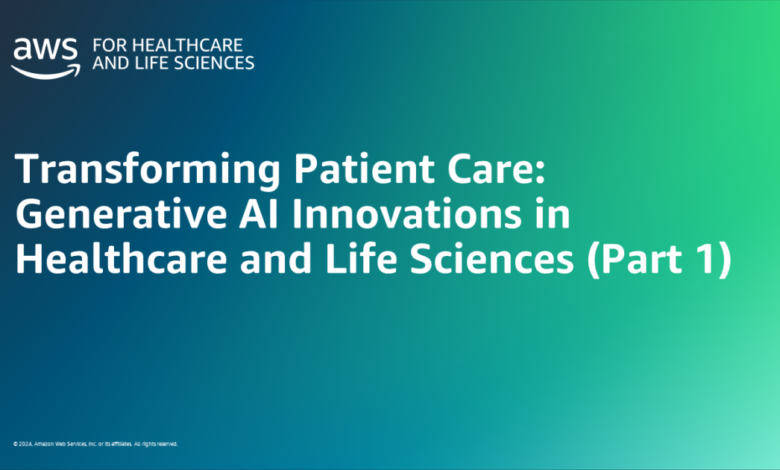Transforming Patient Care: Generative AI Innovations in Healthcare and Life Sciences (Part 1)

As early adopters of artificial intelligence (AI), healthcare and life science organizations are among the most enthusiastic and advanced users of generative AI. The transformative technology has undergone a remarkable evolution in the past year, propelling innovations once considered science fiction into reality – with the potential to transform these industries and significantly improve patient outcomes and experiences. The stakes are high: generative AI could generate up to $360 billion in annual U.S. healthcare savings and $60-110 billion in annual value for pharma and medtech. However, keeping pace with this rapidly evolving technology landscape can be dizzying for organizations. A recent survey of health system executives found 75% believe this technology can reshape the industry, yet only 6% have an established strategy, with “lack of expertise” and “resource constraints” cited as the top barriers.
We will be discussing these opportunities and barriers at our upcoming AWS Life Sciences Leaders Symposium in Boston on May 2. This annual event presents an opportune moment to reflect on and look ahead at the profound impact generative AI is having on the healthcare and life sciences industry. This blog post marks the beginning of a series that will explore the impact across the entire healthcare and life sciences spectrum, deep-diving into use cases, sharing technical insights, highlighting solutions, and showcasing customer success stories. In this first blog, I’ll cover three emerging areas where healthcare and life science customers are focusing their generative AI strategies and investments, but let’s first step back and examine just how much has changed over the past year.
Looking Back: Generative AI Innovations
We’ve spent the past year diving deep with industry-leading customers to build use case based, compliant solutions that accelerate innovation. Customers like Pfizer are generating scientific content and patent applications, enabling medical breakthroughs to reach patients faster while potentially saving $750 million-$1 billion annually. Merck is using generative AI to reduce false rejects in drug manufacturing by over 50%, improving medicine availability and potentially saving patient lives. In healthcare, Solventum (formerly 3M HIS) and Netsmart are streamlining clinical documentation by automating note-taking, allowing physicians to prioritize patient interactions while still capturing comprehensive records, alleviating documentation burdens and enhancing the overall physician-patient experience.
We’ve made significant investments across the full generative AI stack over the past year. On the infrastructure layer, we’ve expanded our GPU offerings and launched next-generation custom AI chips – Trainium for training and Inferentia for inference – while enhancing Amazon SageMaker for efficient, responsible custom model development. In the middle layer, we launched Amazon Bedrock, providing access to diverse foundation models from leading AI companies and enabling extensive customization through precision guardrails, knowledge ingestion, and efficient fine-tuning. At the application layer, we launched purpose-built generative AI solutions like the interactive enterprise chat assistant Amazon Q and the clinical documentation service AWS HealthScribe. This comprehensive full-stack approach streamlines healthcare and life science organizations’ ability to develop and operationalize transformative generative AI solutions.
We’ve also deepened our collaborations with our leading generative AI partners. This includes expanding our strategic collaboration with NVIDIA to offer BioNeMo models for computer-aided drug discovery on SageMaker and AWS HealthOmics. We’ve also partnered with Anthropic to offer Claude 3, the best performing large language model in the world, on Bedrock. These investments have established the foundation to make AWS the easiest way to build and scale secure, privacy-compliant generative AI applications tailored to healthcare and life science customer use cases.
Looking Ahead: Emerging Generative AI Trends for Healthcare and Life Sciences
Looking into the future, we are seeing customer interest and investments across a few areas which could shape how healthcare and life science organizations use generative AI over the next 12 months.
The first is an increased proliferation of foundational models. Not only will the large AI companies continue to release larger and more intelligent frontier models, but startups are increasingly well-suited for domain-specific models trained on areas like biological data, medical imaging data, and clinical data. This emphasizes the need to be able to select the right model, or potentially mix and match multiple models, for your use case.
The second area is customers rethinking their current workflows to make the most of generative AI across their organization. One key challenge is integrating generative AI not only into specific tasks but into a larger end-to-end flow. Agents for Amazon Bedrock enable healthcare and life science customers to autonomously execute complex tasks, learn and adapt, and generate novel task outputs. Customers can then integrate generative AI agents into their existing processes and tools, such as HealthOmics used for running genomics and bioinformatics workflows, to chain together and orchestrate multiple generative AI-powered tasks into a single streamlined workflow. One example is creating a “lab in the loop model” where data and information flow from experimental scientists back to computational teams to accelerate drug R&D at unprecedented scale.
Finally, customers are focused on creating a strong data foundation. Developing a robust data strategy isn’t new, but it has become even more critical because data is your generative AI differentiator – and generative AI can help you get there faster. Services like Amazon DataZone help catalog, discover, share, and govern data assets, and now with AI Recommendations, customers can automate the traditionally manual process of data cataloging and metadata generation, enhancing data discoverability, usability, and trustworthiness. Establishing a modern data strategy breaks down silos and helps clinicians, researchers, developers, and analysts find answers and generate insights faster and integrate new data back into their generative AI models and workflows.
Conclusion
We are at the very beginning of the generative AI adoption curve for healthcare and life sciences. While impressive advancements were made in the past year, there’s much more transformative innovation to come as we continue investing in generative AI for these industries, pushing the boundaries of what’s possible while prioritizing responsible practices and ethical considerations.
Stay tuned for the next installment in this series, where we will dive deep into leveraging generative AI for drug R&D use cases.



